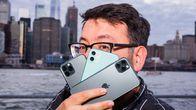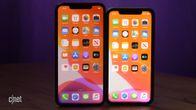Last September, Apple announced the iPhone 11, 11 Pro and 11 Pro Max as updates of iPhone XR , XS and XS Max, respectively. The new phones have significantly improved the cameras, an ultra-fast processor and better build quality. To top it off, the iPhone 11, which starts at $ 699 (£ 729, AU $ 1,199), is $ 50 cheaper than the iPhone XR when it was first released. And just for info, there's a new $ 399 iPhone SE for 2020.
Between the iPhone 11, 11 Pro and 11 Pro Max, it can be difficult to determine which one you should get. The three phones have the same processor, the same main cameras, ultra wide and selfie and work iOS 13. In fact, the iPhone 11 Pro and 11 Pro Max are identical in almost every respect except for the price, size, weight, battery life and screen resolution. The iPhone 11 represents one of the best values for a flagship phone that you can buy today, and has many of the same 11 Pro features. On the flip side, the iPhone 11 Pro has a few key additions that make it the best iPhone ever. At $ 999 (£ 1,049, AU $ 1,749), it also starts at $ 300 more than the iPhone 11.
For more Apple
Subscribe to the Apple newsletter, receive notifications and view articles on CNET.
For six months, I used the iPhone 11 as a daily driver and the 11 Pro as a business phone. I took a lot of photos and videos with the new ultra wide angle camera, pushed the A13 processor to its maximum with games and photo editing and explored all that iOS 13 has to offer.
For most people, including myself, the iPhone 11 is more than enough, and going even further, I would actually pay $ 50 more for the 11 to improve storage from 64 GB to 128 GB. But here's the wrinkle: the size. The iPhone 11 Pro is a bit smaller and lighter than the 11, which I personally like, and that could be the reason for becoming Pro. (FYI, if you want something bigger, with the longest battery life, the iPhone 11 Pro Max waiting to fill your pocket and empty your bank account even more.)
Angela Lang / CNET
At the heart of the iPhone 11 Pro is an iPhone 11. But with improvements such as a high-resolution OLED screen, a matte glass finish and a stainless steel side strip, it receives VIP treatment. It has a third rear camera which, combined with Apple's new Deep Fusion image processing, takes better zoomed photos. But the most popular upgrade to the 11 Pro is probably the battery life compared to the iPhone XS of the previous generation. In fact, the 11 Pro lasts almost as long on a single charge as the 11.
Read our review of the iPhone 11 Pro.
How we tested

The little iPhone was better
Size is perhaps the most obvious and most important reason to buy the iPhone 11 Pro compared to the iPhone 11. These are phones of very different sizes and they will hold in your hands differently.
With a 5.8-inch screen and a weight of 6.63 ounces (188 grams), the iPhone 11 Pro is the smallest of the three iPhone 11 devices. (Although, if you're looking for a small phone, the new iPhone SE might be a better option, at 4.7 inches and 5.22 ounces.) The rugged phone is the easiest to use with one hand. Weighing 6.84 ounces, the iPhone 11 is heavier than the 11 Pro but doesn't seem as dense. The iPhone 11 is 0.2 millimeters thicker than the 11 Pro, which makes it feel a bit big.
Everyone's hands and needs are different. I have big hands, but I prefer the slim feel of the 11 Pro. But if you're ready to compromise a heavier weight for a larger screen, get 11 and save $ 300.
And if you want the largest absolute screen you can get, go for the $ 1099 iPhone 11 Max which has a 6.5-inch OLED screen but weighs 7.97 ounces (226 grams).
Winner: For its small size, the 11 Pro is the way to go for me.
Telephoto is nice to have
The iPhone 11 Pro (and 11 Pro Max) has a third telephoto lens that the iPhone 11 does not have. Sometimes it was nice to switch to telephoto. And compared to the iPhone XS, the updated telephoto camera combined with Deep Fusion processing allowed me to take pictures with better image quality.
There were also times when I framed a photo better with the 11 Pro telephoto lens than with the main camera. For example, when I took a photo from top to bottom of a plate of food with the main camera, I could see the shadow of the phone on the plate. But when I switched to the telephoto lens and moved the phone away from the table, there was no shade.
There are however some caveats regarding the telephoto lens of the iPhone 11 Pro. When taking photos in 2x night mode, the 11 Pro does not use the telephoto lens. Instead, you need to crop the main wide-angle camera. In addition, the telephoto lens excels in bright conditions, but when I take pictures in medium to low light, I see better picture quality when I take the same picture with the main camera and crop.
Overall, the telephoto lens is useful on the 11 Pro, but I did not fail to have it when I used the 11. If I needed to zoom in on a photo, a 2x crop of a photo I took with the main camera worked well. I recommend looking at the photos you have on your current phone and seeing how many were zoomed in and how many photos would have been better if you could have zoomed in a bit. If you have a lot of photos where you wish you had a dedicated telephoto lens, then you should consider an iPhone 11 Pro.
To learn more about the iPhone 11 and 11 Pro cameras, check out our comparisons below:
Winner: The 11 Pro telephoto lens is a nice accessory if you enjoy photography on iPhone, but it is certainly not necessary
Take a look at the photos of the iPhone 11, 11 Pro and 11 Pro Max
IPhone 11 Pro has a beautiful OLED screen
The iPhone 11 Pro has a 5.8-inch OLED screen, while the 11 has a 6.1-inch LCD screen. When I look at the phones side by side, the screen of the 11 Pro was more beautiful, brighter and displayed more details. It's a pleasure to watch videos and edit photos.
The 11 Pro's OLED screen supports HDR and has a contrast ratio (the brightest and darkest color ratio on a screen) of 2,000,000: 1 compared to 1,400: 1 on 11. On paper, this means that the iPhone 11 Pro is capable of darker black levels and more color saturation. That said, side by side, the differences between the two screens are sometimes difficult to notice. As such, the colors on the iPhone 11's LCD screen are precise and the videos are beautiful.
The iPhone 11 Pro Max has a 6.5-inch OLED that has the same pixel density as the iPhone 11 Pro.
Winner: The screen of the iPhone 11 is good, but that of the 11 Pro is even better.
Cracked screens and sealing
We put both iPhone 11 and 11 Pro through a test where we dropped them of different heights. After dropping them 3 feet, 6 feet and 8 feet from the ground, the two phones survived without a single crack on their screens or glass backs. The only flaw was a small scratch on the aluminum strip of the iPhone 11 and a few damaged pixels at the bottom of the screen of the 11 Pro.
Regarding water resistance, these two phones are IP68 rated. Apple claims that iPhone 11 can withstand immersion at a depth of 6.5 feet (2 meters) for up to 30 minutes and that the 11 Pro can survive at a depth of up to 13 feet (4 meters) 30 minutes. however, in our water tests with an underwater drone, the 11 and 11 Pro both survived submerged for 30 minutes at 39 feet (11.9 meters).
Winner: To attach; the iPhone 11 and 11 Pro are among the most durable phones you can buy today,
Color, finish and extras
After six months of use without a case, the backs of the iPhone 11 and 11 Pro still did not have a single scratch or scratch. The textured matte glass back of the iPhone 11 Pro is soft, smooth and durable. The phone is easy to grip and never feels like it will slide out of my hand (although its smaller size helps this). I am happy to say that fingerprint stains do not accumulate easily.
The iPhone 11, meanwhile, has a shiny glass back, which looks slippery in my hand and the phone is also prone to stains.
As for colors, the iPhone 11 does better than the 11 Pro. You can buy an iPhone 11 in six bright and fun colors. The 11 Pro is less flashy and comes in four fairly serious finishes (space gray, silver, gold or midnight green). In a perfect world, I could have the matte glass finish of the 11 Pro and the color options of the 11.
IPhones have wireless charging and support fast charging, but only the iPhone 11 Pro (and 11 Pro Max) comes with the 18-watt charger required for fast charging. It is aggravating to note that the 11 does not come with this charger and that you will have to buy it separately if you wish. To make matters worse, Apple charges $ 29 (£ 29, AU $ 49) for the 18-watt fast charger and $ 19 (£ 19, AU $ 29) for the cable, when cheaper compatible alternatives are available.
Winner: On the only colors, the iPhone 11 takes this one.

